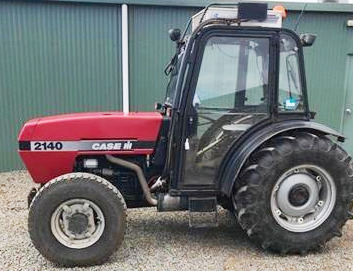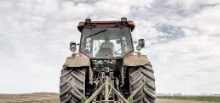________________________________________________________________________________________
| Home / Farm Tractors / Case IH Tractors / Case IH 2140 |
Case IH 2140 Troubleshooting
 The
Case IH 2140 is a 2-wheel drive or 4-wheel drive orchard/vineyard tractor from
2100 series. This model was manufactured by Carraro built between 1988 and 1993.
The Case IH 2140 tractor is powered by SLH 1000.4A 4-cycle 4-cylinder air-cooled
diesel engine with a max output power of 61 hp (45.2 kW) and 233 Hm (172 lb-ft)
of max torque at 1200 rpm.
The
Case IH 2140 is a 2-wheel drive or 4-wheel drive orchard/vineyard tractor from
2100 series. This model was manufactured by Carraro built between 1988 and 1993.
The Case IH 2140 tractor is powered by SLH 1000.4A 4-cycle 4-cylinder air-cooled
diesel engine with a max output power of 61 hp (45.2 kW) and 233 Hm (172 lb-ft)
of max torque at 1200 rpm.
The Case IH 2140 is fitted with 2 transmission options: 8x8 partially synchronized transmission, or 12x12 partially synchronized transmission. Max. forward and reverse speed - 18.1 mph (29.2 km/h).
The open center hydraulic system used a gear pump with a flow of 15.6 gal/min (59 l/min). The 2-wheel drive models are equipped with 7.50x16 front tires and 13.6R28 or 14.9R28 rear tires. The 8.25x16 or 7.50x18 front tires and 13.6R28 rear tires are used for tractors with 4-wheel drive. The wheelbase is 83.1" (2110 mm) for 2WD models and 81.7" (2070 mm) for 4WD models.
| Diesel Engine Troubleshooting |
| Engine difficult to start or will not start |
Air in the fuel lines - Bleed the fuel lines.
Clogged fuel filter - Change filter element.
Fuel injection nozzles are damaged - If necessary, replace with a new nozzle.
Dirt or water in fuel system - Drain water or flush dirt from the system.
Improper valve clearance - Correct valve clearance.
Fuel injection pump damage - Rebuild or change fuel pump.
| Engine starts but stops suddenly |
Restricted intake air - Service air cleaner.
Fuel filter plugged - Clean or change the filter.
Fuel injection pump is leaking - Repair any leaks.
Fuel injector fault - Clean or replace fuel injectors.
Fuel injection pump is not operating properly - Replacement or repair required.
| Engine shuts off suddenly while running |
Engine is cold - Warm up the engine.
Dirty fuel filter - Change filter element.
Air trapped in fuel system - Bleed air.
Fuel injection nozzles are faulty or clogged - Service or change injection nozzles.
Fuel injection pump timing is not adjusted - Set it up as required.
| Engine stops at low idle speed |
Low idle speed setting is not correct - Normalize low idle speed.
Defective fuel injection pump - Replace injection pump or repair it.
Defective fuel injectors - Change or clean fuel injectors.
Excessive valve clearance - Adjust valve clearance.
| Engine power is too low |
Air cleaner is dirty - Carry out maintenance on air filter.
Clogged or defective injection nozzles - Inspect nozzles and replace if necessary.
Fuel injection pressure is wrong - Check the fuel injection pressure and adjust if necessary.
Incorrect valve clearance - Check and adjust as required.
Incorrectly set low idle speed - Correct low idle adjustment.
Restricted fuel hoses or lines - Fuel lines and hoses need to be cleaned.
Damaged cylinder-head gasket - Install new cylinder head gasket.
Defective or worn piston rings - Piston rings replacement required.
| Engine overheating |
Insufficient coolant - Add coolant fluid and inspect the cooling system for leaks.
Engine oil insufficient - Checking oil level and add if necessary.
Damaged radiator cap or dirty radiator core - Change cap or clean radiator.
Fan belt slipping or worn - Belt replacement is recommended.
Engine is overloaded - Load reducing required.
| Oil pressure is insufficient |
Oil level is insufficient - Checking oil level and add if necessary.
Oil filter clogging - Change or service engine oil filter.
Incorrect engine oil Use oil of proper viscosity.
Crankshaft bearing has excessive oil clearance - Bearing replacement required.
Oil pump malfunction - Remove and inspect oil pump.
| Engine knocking sound or abnormal noise |
Insufficient engine oil - Fill up the engine oil.
Engine is not fully warmed up - Warm up the engine.
Fuel injection pump timing is wrong - Set the fuel pump timing correctly.
Wrong adjustment of low idle speed - Correct low idle adjustment.
Fuel injectors are dirty or defective - Replace fuel injectors.
Misaligned or faulty connecting rod - Align or change connecting rod.
Broken or worn pistons - Pistons need to be replaced.
| Transmission Troubleshooting |
| Insufficient transmission fluid pressure |
Low oil level - Add oil to the transmission housing.
Transmission fluid filter is clogged (if fitted) - Replace or service transmission fluid filter.
Relief valve is damaged - Replace valve as required.
| Transmission is making noise |
Insufficient transmission fluid - Need to add transmission fluid.
Transmission oil is contaminated - Change the oil.
Defective gears or improper backlash - Install new gears and set backlash correctly.
Worn or damaged bearings - Install new bearings.
Worn or bent shift forks - Change defective shift forks.
Shaft splines are damaged or worn - Replace defective shaft.
| Gear shift is hard |
Gear shift linkage is rusty or worn - Install new shift linkage.
Damaged or worn gear shift forks - Shift forks need to be changed.
Worn parts of the gear shifting mechanism - Change worn parts.
Worn or improperly adjusted clutch - Adjust correctly or replace.
| Transmission oil leakage |
Transmission fluid level is high - Correct the fluid level.
Broken seals or gaskets - Install new components.
| Hydraulic System Troubleshooting |
| Insufficient hydraulic oil pressure |
Hydraulic oil level low - Fill the system to proper hydraulic oil level.
Hydraulic oil filter is clogged - Change the hydraulic filter element or service if required.
Hydraulic pump malfunction - Repair or replace hydraulic fluid pump.
Hydraulic control valve block is out of adjustment - Control valve needs to be adjusted.
Defective hydraulic cylinder - Repair or change hydraulic cylinder.
Leaks in hydraulic lines - Check the system and repair leaks.
| Hydraulic system overheating |
Main relief valve is damaged - Change relief valve.
Hydraulic oil type is wrong - Correct type of oil must be used.
Contaminated hydraulic oil - Change hydraulic oil.
Air in hydraulic lines - Bleed hydraulic lines.
| Hitch does not raise or raises very slowly |
Excessive hitch loading - Reduce hitch load.
Hydraulic oil level low - Need to add oil.
Clogged hydraulic fluid filter - Service or replace the hydraulic filter.
Defective hydraulic pump - Change or repair hydraulic fluid pump.
Faulty main relief valve - Relief valve need to be replaced.
Hydraulic control valve block is faulty - Replace or repair the valve.
Hydraulic cylinder failure - Repair or install a new hydraulic cylinder.
Suction line is disconnected or broken - Replace or connect correctly.
| Hitch fails to drop or drops slowly |
Hydraulic control valve block is out of adjustment - Control valve needs to be adjusted.
Hydraulic cylinder is broken - Install a new hydraulic cylinder or repair it.
Misadjusted hitch - Adjust three-point hitch as required.
Damaged hitch cross shaft - Change the shaft.
| Hitch lowering or lifting is jerky |
There is air in the hydraulic system - Bleed hydraulic system.
Contaminated hydraulic fluid - Change hydraulic fluid.
Damaged hydraulic pump - Repair or replace hydraulic oil pump.
Defective hydraulic spool valve - Repair or change the valve.
Hydraulic cylinder failure - Install a new hydraulic cylinder or repair it.
| Steering Troubleshooting |
| Hard Steering |
Incorrectly fitted or worn steering column - Refit or replace the steering column.
Air lock in the steering system - Bleed the steering system.
Improper toe-in - Adjust toe-in properly.
Uneven tyre pressure - Inflate the tyres properly.
Steering pump is faulty - Replace or repair steering pump.
Steering pump control valve is faulty or stuck - Change or flush control valve.
Steering oil insufficient - Check and refill steering oil.
| Excessive free play of steering wheel |
Worn steering column shaft or coupling - Change defective component.
Steering pump is faulty - Install a new steering pump.
Loose or worn steering linkage parts - Repair or change steering linkage.
| Front wheels wander to right or left |
Front tires wear unevenly - Change the tires.
Not adjusted toe-in - Check and adjust toe-in.
Steering linkage joints are worn or loose - Change or repair steering linkage.
Front wheel bearings are worn or incorrectly adjusted - Replace or adjust the bearings correctly.
| Electrical System Troubleshooting |
| Battery cannot be charged |
Wiring connections are loose or corroded - Clean or tighten connections.
Battery terminal clamps are defective - Install new terminal clamps.
Defective battery - Battery replacement required.
Belt is defective or loose - Change belt or adjust belt tension.
| Starter cranks slowly |
Battery power is low - Battery is drained, recharge it.
Battery drains quickly - Service or replace the battery.
Corroded battery terminals or disconnected wires - Connect wires properly or change terminals.
| Starter is not cranking |
Battery is drained or worn - Change or recharge battery.
Battery wiring is disconnected or improperly connected - Inspect wiring and connect as required.
Battery voltage is low - Battery needs to be recharged.
Defective starter motor - Replace or repair starter.
________________________________________________________________________________________
________________________________________________________________________________________
| Farm Tractors Technical Specifications |
